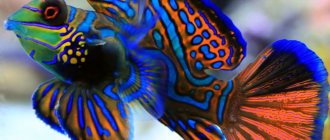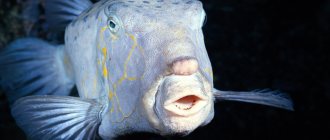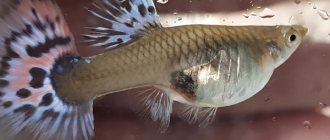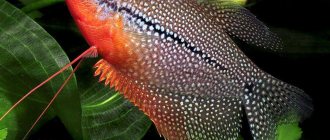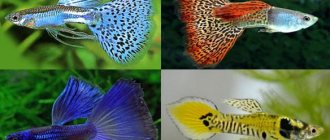Home of the guppy fish
Without exaggeration, this is the most common and popular aquarium fish in the world. She swam to us from the fresh and brackish waters of the northern part of South America and nearby islands. There it lives in cool, clear waters and looks different from the aquarium fish we are used to.
Wild guppies differ sharply in appearance from domesticated ones.
Did you know that guppy fish have been discovered several times? Three scientists from different countries described this species of poeciliids at different times, but the fish gained fame after the report of the English scientist Robert John Lechmere Guppy in 1886. Gupeshki gained worldwide popularity, among other things, because of their taste preferences. They eat mosquito larvae, worms, bloodworms and small insects. Therefore, in order to get rid of insects, guppy fish were placed in wild reservoirs around the world. Even in Russia there are wild populations of this species. However, this is more likely a matter of negligence of aquarists than of pest control. In Moscow (Lyubertsy), Tver, Yaroslavl, Rybinsk and Nizhny Novgorod, there are feral self-reproducing colonies in areas where warm water is discharged and in settling ponds with a constant temperature.
Their morals. Guppies sleep by sinking closer to the bottom and hovering in the water. Typically, fish are kept in the middle and upper layers of the aquarium.
Guppies in the wild
The historical homeland of the fish is the currents off the northern coast of South America (Venezuela, Guiana) and the coastal waters of the northern part of Brazil. With the development of civilizations, people discovered the ability of guppies to fight malaria mosquitoes.
This factor served as the impetus for the spread of representatives of this species to water bodies in various parts of the planet. The fish is distinguished by its high survival rate. It easily adapts to the climatic conditions of the environment.
Over time, man domesticated fish. But she has not lost her natural resistance to negative manifestations in her habitat. This has made guppies a popular species for breeding in aquariums.
Maintenance and care
Before we discuss this. How to care for guppies and what to feed them, let's look at the table. Suitable water parameters for guppies at home:
| Volume of water per individual | Temperature (°C) | Acidity (pH) | Hardness (mol/m³) |
| 2.5 liters | 22-26 | 6,5-7,8 | 10-25 |
| The table shows average indicators | |||
Temperature extremes for the life of guppies vary over a huge range from 14 to 33 °C. However, living at extreme degrees will significantly increase the risk of illness and premature death of your pet. The average lifespan of a guppy is 3 years.
Based on this table, it is clearly seen that creating suitable conditions for the life of guppies is quite simple. These Latinas are very picky. However, you should not think that this gives you the right to care for them carelessly. In order for the fish to feel comfortable, their color to be bright, their behavior to be interesting, and their health to be strong, another important aspect is necessary - aeration. Along with filtration, aquarium aeration is vital for fish. You can use a 2in1 filter and compressor to save space in your aquarium.
Guppies are easy to care for and a beautiful sight to see.
The ideal aquarium for guppies is planted along the back wall. This way, the green filters will not interfere with swimming and playing, but can serve as a shelter in a stressful situation. Any plants are suitable because... guppies are rarely eaten. And in order to completely eliminate such behavior, fresh cucumbers, lettuce, and spinach should be introduced into your pet’s diet. The latter should be doused with boiling water before use. Such dishes should be served no more than once a week. Another reliable source of plant food is ready-made dry mixtures. So, we come to an important topic:
How long can guppies live with proper care?
Male guppies can live up to 3 years, females - up to 4-5. Water temperature has a big influence on this. The higher it is, the shorter the life of the fish. In warmth, all the basic processes of the guppy's body are accelerated, which leads to a short life cycle. To prolong the life of fish in an aquarium, it is important to avoid overfeeding, ensure disease prevention by adding table salt (1 teaspoon per 10 liters of water), keep no more than 5-7 fish in one vessel, and strive to recreate their natural habitat.
Nutrition
Gupes need to be fed 2 or 3 times a day, in small portions. All uneaten food remains must be removed from the aquarium. Otherwise, rotting products will poison the water. As mentioned above, in the natural environment, fish feed on insect larvae and themselves. Because of this, in aquarium life they are happy to feast on food rich in protein. They feast on live food with special pleasure. But you can’t call them picky; they eat what they give. For full growth and development, guppies are fed:
- Bloodworm,
- Koretroy,
- Pipe maker,
- Artemia,
- Spirulina,
- Chlorella,
- Ready-made dry mixes.
Guppies, like any other fish, need to have fasting days. Leave your pets without food once a week, this will improve their digestive system and clean the aquarium properly.
Natural habitat
The islands of Tobago and Trinidad are rightfully considered the homeland of this species. As a rule, this species of fish lives exclusively in running, clean water, but they have also been seen in coastal brackish waters.
The diet of guppies in nature consists of larvae, worms, bloodworms, and a variety of small insects. Thanks to this, people began to breed them in those areas where a huge number of malaria mosquitoes live, because the fish simply eat its larvae.
An important nuance is that the male guppy aquarium fish is much brighter than the female. Thanks to their color, they protect themselves from predators, because the fish itself is defenseless and small in size.
Compatibility with other inhabitants
Guppies are unusually easy-going, so they can keep company with any aquarium animal of similar size and temperament. They do not offend other fish and snails, but they will happily eat shrimp. This is especially true for medium-sized cherry shrimp. Even if the adults manage to escape, the inexperienced babies will definitely end up with the predatory guppies for dinner.
But the fish themselves can suffer from the claws of cancer or the teeth of aggressive relatives. Sumatran barbs and angelfish will not miss the opportunity to chase the beautiful developing fins and tails of males. This game can even lead to death. Shark Baloo or pangasius, due to their large size, also will not make friends with guppies. They will mistake the latter and their offspring for food and eat them with pleasure.
Poeciliids, corydoras, sucker catfish, zebrafish, and neons will be good neighbors.
Choose neighbors for your guppies based on this table.
If, after reading the compatibility table, you decide to create a species aquarium, then I will give you a formula for calculating the volume of water for guppies. For example, you have a 30 liter aquarium, how many fish should you put there? First, let’s subtract from the total volume the soil, equipment and decor, which on average for this size of an aquarium will take from 5 to 10 liters. The edge of the water is 1-1.5 cm below the edge of the aquarium, this takes us about another 2-3 liters. Thus, we are no longer talking about 30, but about 20 liters. Based on the above table, one individual needs 2.5 liters of water 20/2.5=8. 8 guppies can be placed in a 30 liter aquarium. The ratio of male to female guppies is 2:1, so you need about 3 males and 5 females.
Water volume
The size of the aquarium directly depends on the number of guppies that live in it, as well as on the quality and efficiency of filtration. However, the larger the aquarium, the easier it will be to maintain acceptable water quality. A large volume of water will act as a buffer, softening an unexpected blow to aquatic life. Agree, Lake Baikal is a more stable ecosystem than a city pond in your city. But if you don’t have the opportunity to use a larger aquarium, it’s okay, you’ll just have to discipline yourself and change the water regularly.
Reproduction
Sexual differences in gupeshkas are obvious. Even a person ignorant of aquariums will notice that the appearance of the male is the most advantageous. It is brighter colored and smaller in size than the female. Which, for protective purposes, wears more modest colors and is large in size for raising babies.
Sexual differences in guppies.
Guppies, like the platypus among mammals, are carriers of a wonderful method of reproduction. Fertilization of eggs occurs directly in the mother's body. After courtship, the male, using a tube-shaped anal fin - the gonopodium, injects milk onto the eggs located in the body of the expectant mother. Then the female carries the eggs in her stomach for 5-7 weeks. And gives birth to viable fry. Thus, guppies are viviparous fish! Not one of a kind, but amazing nonetheless!
After giving birth, the female acquires a strange interest in the fry - food. Mother, father and other relatives are ready to immediately swallow the babies. Therefore, you should remove a pregnant female if you plan to raise fry. Or arrange additional shelters for babies in a common aquarium. After a couple or three months, the surviving babies will look like their parents and acquire a size of 1.5-2 cm.
What does it take for guppies to reproduce? You need to pour water into the aquarium!
Breeding
Sex differences
No matter how small these fish are, it is not so difficult to distinguish a “boy” from a “girl”. Girl guppies are larger, their bellies are larger, but their coloring is paler. In males, the coloring is not only brighter, but it also appears on the body of the fish at a very young age. A sure sign: whichever of the fish “dressed up” first is the “boy”. The caudal fin of males is larger than that of females, and the anal fin serves as a gonopodium, that is, with its help, male guppies fertilize females.
Getting offspring
Breeding guppies is not a difficult task. These viviparous fish can give birth even without a male: once fertilized, an adult can become a mother up to eight times. The development of the fry inside her body lasts from 35 to 45 days. The size of the “brood” can also be different: young mothers will bring a dozen children, and experienced mothers who have already given birth will bring up to a hundred.
How to determine the approach of labor? In a pregnant female, a spot located in the area of the anus begins to darken. The darker it is, the sooner labor will occur.
Sometimes an amazing thing happens: the guppy gives birth exclusively to “girls.” Why? Scientists have not yet been able to establish the exact mechanism of such regulation, but most likely this is a protective reaction of the female body to an excess of males.
Health
Under the right conditions, responsible care and a balanced diet, guppies are healthy pets that do not cause any trouble. However, with serious lapses on the part of the owner, even robust guppies can get sick. The most common diseases and symptoms are:
- Tail splitting (due to poor water quality, injury or fin rot);
- Curved spine in guppies (congenital anomaly, trauma, overeating or dangerous fish tuberculosis);
- Semolina and other infectious diseases (viral, fungal, bacterial infection or poor water quality).
Based on the above, guppies are a strong, hardy and active breed that requires standard care. In which the fish’s immune system will work correctly, and therefore reflect negative factors.
It should be remembered that selective forms of guppies, obtained through complex inbreeding and other tricks, have weaker immunity in relation to “mutts”.
How to feed a guppy
For successful maintenance and breeding of guppies, special attention should be paid to the feeding regime. The best food is always live food, but the best growth and color are the result of greater variety in the diet, whether live or not. Live foods such as wingless fruit flies, white worms, daphnia, and mosquito larvae will be well received. All of this is also very acceptable frozen. Then there are many types of dried food and different flakes such as spirulina. Good quality food gives us stronger guppies that will be more resistant to infection or disease. Guppies are omnivores and will readily accept any food offered. In the video below, guppies eat worms through a special feeder:
When feeding newborn guppies, I always use newly hatched brine shrimp, but dilute them with microworms as well as brine shrimp powder (I mix it with water and pour small amounts into the fry containers). It is very important to feed little and often. Continuous feeding with a wide variety of food produces great results with the progressive development of guppy fry.
And these are brine shrimp, food for fry
Feeding
Feeding, as well as general care for guppies, will not cause difficulties even for a novice aquarist.
Let's start with the fact that guppies are omnivores. But this does not mean that you can ignore their diet and feed them anything. Guppy nutrition should be varied and balanced. Only this will allow you to grow beautiful and healthy fish capable of reproduction.
The basis of the diet are living organisms. These can be daphnia, coretras, bloodworms, tubifex worms, and brine shrimp. From time to time you can give fillets of squid, river or sea fish, after finely cutting them. Since living organisms are practically unavailable during the cold season, you should stock up on them in advance by freezing the required amount. The diet at this time can be supplemented with low-fat cottage cheese, omelettes, cheeses, fish caviar, slightly boiled semolina or chopped oatmeal, soaked bread and biscuits. Naturally, all this must be crushed.
In addition, it is necessary to include plant foods, although they should be present in the diet in smaller quantities than animal foods . Sea kale and greens (spinach, parsley, lettuce, nettle leaves) are ideal. Green leaves must be doused with boiling water and finely chopped.
Plant foods should only be on the menu for adults. It is better to make the days on which the fish receive plant food as fasting days. There should be no more than two fasting days per month.
Vitamins. No matter how carefully the menu is thought out, you cannot do without vitamins. There are several ways to give vitamins to fish.
- Add a few drops of oil solutions of essential vitamins (A, E, D) to dry food and mix thoroughly. This mixture can be stored for no more than two to three days.
- The vitamin tablet must be thoroughly crushed, dissolved in water (preferably distilled), then sprinkled with this solution on live food. After a few minutes, when the vitamins are absorbed, the food can be given.
Food with vitamins should be given once or twice a week. Dosage – you can add 2-3 drops of vitamins to a matchbox of food. An excess of vitamins is just as bad as a lack of them: the fish get sick and may even die .
Feeding in the first week after birth deserves special attention. It is recommended to focus on artemia, daphnia, small bloodworms, and fruit flies. But it is better to exclude tubifex and enchytrea from the menu of both newborn fish and pregnant females, since they contain few useful substances.
Store-bought food makes life a lot easier, but try to diversify your pets' diet.
Dry food. Pet stores offer a large selection of special dry food for guppies. Sometimes, as an exception, you can give it to fish, but you should not constantly rely on it in the diet.
Number of feedings. Guppies should eat often and in small portions. The minimum number of feedings is two to three times a day. Keep portions small: too large can lead to obesity and death.
How to distinguish a female from a male?
Unlike other fish species, the sex of guppy is very easy to determine visually. First of all, males grow from 2 to 4 cm in length. They have bright colors and a long flowing tail.
The length of females can reach up to 6 cm. The most interesting thing is that they are inconspicuous in appearance and have a short tail, which can sometimes only have small bright spots. In appearance, the female is several times larger than the male and has a dark spot on the lower abdomen. It is surprising that a female can give birth to from several dozen to one and a half hundred fry at a time.

